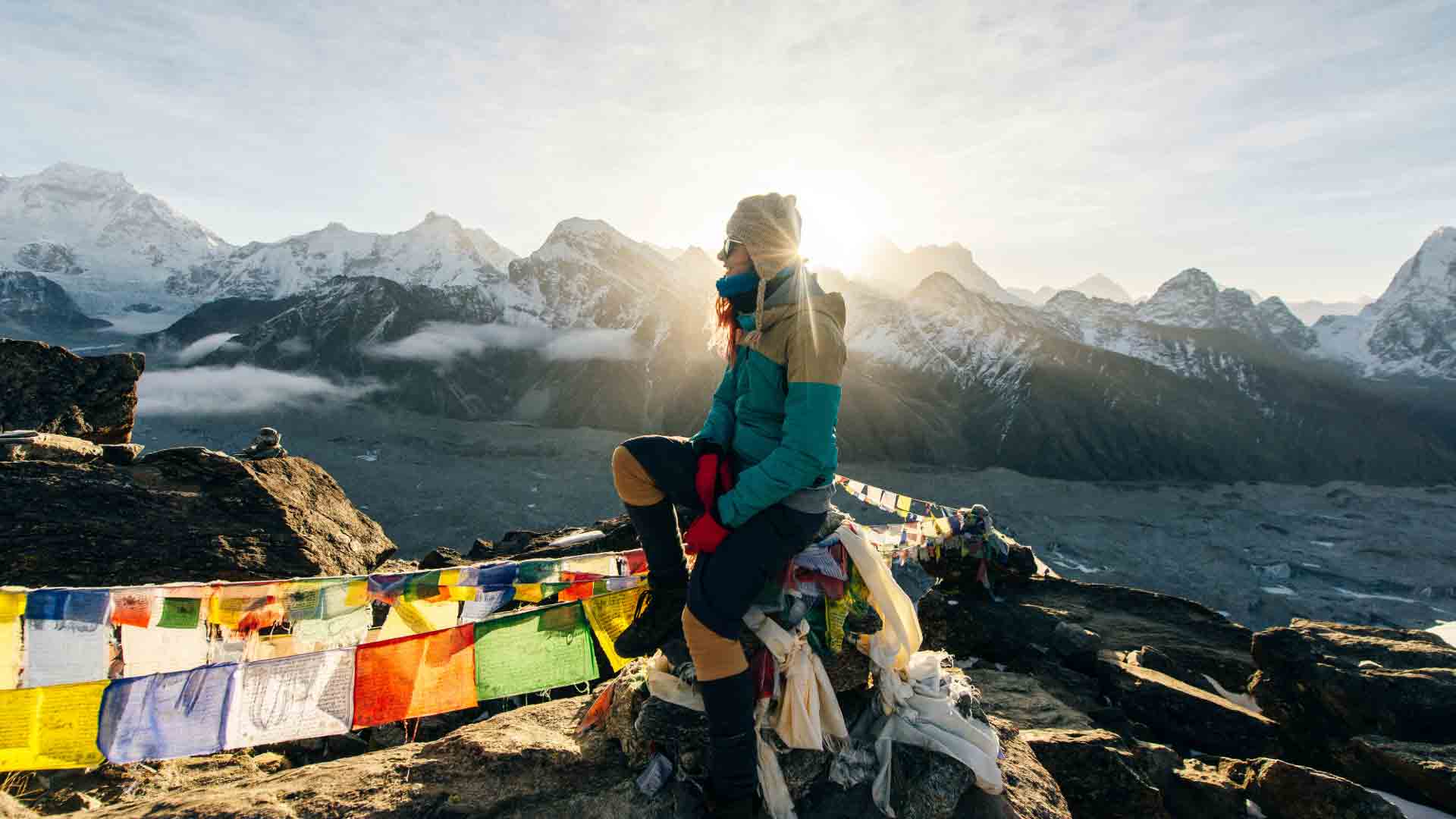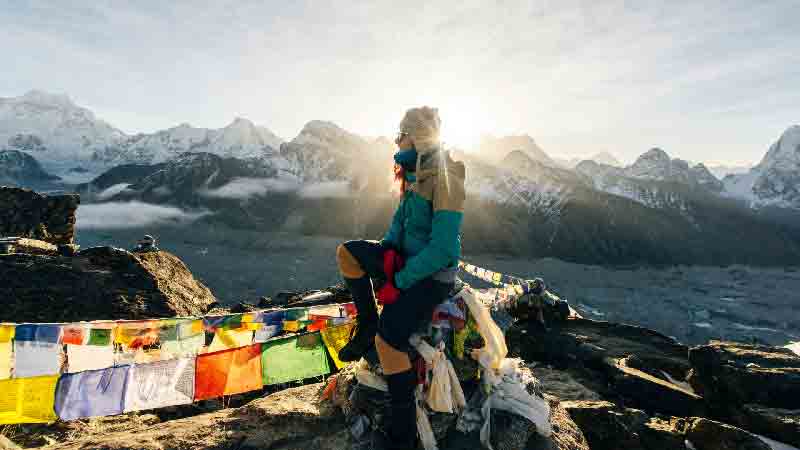

Definitive Gear Guide and Tips for the Everest Base Camp Trek
Are you ready to embark on one of the most exciting adventures of your life? Conquering the majestic Himalayas requires careful planning and the right equipment. Here is a complete gear list and essential tips to ensure you’re fully prepared for your journey to Everest Base Camp.
1. Clothing in Layers: Your Best Ally
The weather around Everest can change dramatically, from sunny days to freezing nights. The key is to dress in layers with technical or merino wool clothing and to avoid cotton as it retains moisture.
-
Head and Neck:
- Light hat or balaclava: A warm fleece hat or balaclava for the cold.
- Sun hat or cap: To protect you from the strong sun.
- Sunglasses: With UV protection.
-
Upper Body:
- Thermal base layer: Shirts made of merino or synthetic fabric that wick away sweat.
- Fleece or windproof jacket: To keep you warm and shield you from the wind.
- Waterproof shell jacket: Breathable, to protect you from rain.
- Down jacket with hood: A 4/5 season jacket, essential for cold nights and for using in teahouses.
-
Lower Body:
- Hiking trousers: Lightweight, elastic, and ideal for day trekking.
- Thermal trousers or leggings: Recommended for extra warmth during the last few cold days.
- Waterproof shell trousers: Breathable, to keep you dry in wet conditions.
-
Feet:
- Thin, lightweight inner socks paired with thick wool hiking socks (double-layered to prevent blisters).
- Waterproof hiking boots: Make sure they are well broken in, with spare laces.
- Camp shoes: Sneakers or sandals to use in teahouses.
- Gaiters: For winter treks to keep snow and mud out (if applicable).
-
Hands:
- Lightweight gloves: For milder conditions.
- Heavyweight gloves or mittens: With a waterproof shell for colder conditions.
2. Backpacks and Gear Organization
- Daypack: A rucksack (30–45 liters) to carry essentials during your trek.
- Duffel bag: For additional gear, which is usually carried by your porter.
- Plastic bags or waterproof covers: To keep your belongings dry inside your bag.
- Trekking poles: Very useful for stability (must be checked in as luggage).
3. Sleeping and Resting Equipment
- Down sleeping bag: Recommended for 4/5 season trekking, essential for the cold nights.
- Teahouses: You will always be staying in teahouses (not tents). If needed, extra blankets can be requested.
- Travel pillow (optional): For additional comfort.
- Down jacket: Advisable for use in accommodations when temperatures drop.
4. Essential Accessories
- LED headlamp: (e.g. Petzl Zoom) with spare batteries.
- Power bank/solar charger: To keep your devices charged, as electricity is limited.
- Reusable water bottle or camelbak (2L): Note that the tube can freeze in the cold.
- Water purification tablets: Recommended, even though water is usually boiled.
- Extra energy bars/snacks: Optional, for quick energy boosts.
- Ear plugs: In case of noisy accommodations.
5. Hygiene and Personal First Aid Kit
- Personal toiletries: Toothbrush, toothpaste (preferably biodegradable), multipurpose soap, deodorant, and moisturizer.
- Quick-drying microfiber towel: A medium-sized towel for personal use.
- Wet wipes and extra toilet paper: Often, there is no toilet paper available in the bathrooms.
- Antibacterial hand sanitizer: For maintaining hygiene.
- Sunscreen and lip balm (50+ SPF): To protect your skin and lips from strong UV rays.
- Essential medications: Bring your usual medicines such as headache tablets and anti-inflammatories.
- Basic first aid supplies: Bandages, plasters, and Compeed for blisters and minor injuries.
- Oral rehydration salts: To help combat dehydration at high altitudes.
- Petroleum jelly (balm): For protecting your lips and feet from chafing.
- Ginger: Bringing a piece of ginger from home can help boost your body temperature and circulation, which is very useful in high-altitude conditions.
6. Money and Cards
- Local currency (Nepalese Rupees): It is best to withdraw the necessary cash upon arrival in Kathmandu.
- ATMs: Available in places like Namche Bazaar (around day 4). Note that not all ATMs accept Visa; American Express and MasterCard are recommended.
- Cash is king: In remote areas and teahouses, card payments are generally not accepted.
7. Altitude and Health Tips
- Acclimatize properly: Take it easy on rest days in Namche Bazaar or Dingboche.
- Hydrate: Drink plenty of water and enjoy soups (such as garlic soup) to maintain energy.
- Monitor your health: Watch out for severe headaches, dizziness, or nausea as signs of altitude sickness, and report them to your guide immediately.
- Travel insurance: Ensure you have coverage for high-altitude trekking and emergency helicopter evacuations.
8. Accommodation and Food
- Teahouses: You will always be staying in teahouses (not tents). They offer basic accommodations with beds and often showers.
- Extra blankets: Can be requested if needed.
- Meals: Typically, breakfast, lunch, and dinner are provided. Traditional dishes like dal bhat will keep you energized for trekking.
Conclusion
With this detailed gear list and essential tips, you’ll have everything you need to make the most of your Everest Base Camp adventure. Proper preparation is key, so pack wisely, train adequately, and secure your travel insurance. Then, set out to explore the breathtaking heights of the Himalayas!
Pack your bag, lace up your boots, and get ready for an unforgettable journey!
